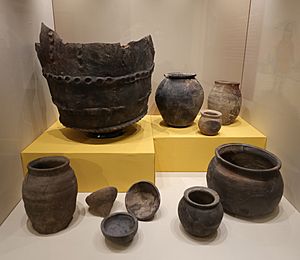Thetford ware facts for kids
Thetford ware is a special kind of pottery made in England a long time ago, during the Middle Ages. People made a lot of it between the late 800s and mid-1100s. This pottery was mostly made in places like Norfolk and Ipswich, Suffolk. It feels hard and sandy, and it's usually grey. People used Thetford ware for many things, like cooking pots, bowls, jars, pitchers, and lamps.
What is Thetford Ware?
Thetford ware is a type of pottery made on a spinning wheel. This helped people make many pieces quickly. The pottery feels hard and sandy. Its color can be light grey, dark grey, or sometimes brownish-orange or light yellow.
People made five main types of Thetford ware:
- Cooking pots
- Storage jars
- Bowls
- Pitchers (for pouring liquids)
- Lamps
Cooking pots came in three sizes, but the medium size was the most common. The lamps often had a tall base that was hollow inside.
Most Thetford ware was plain. Some pieces had simple decorations. These included strips made with a thumb, different patterns made by "rouletting," and carved lines. Rouletting is a way to carve patterns onto pottery using a small wheel with teeth. The patterns often looked like diamonds, squares, or a mix of both.
Where and When Was it Made?
This pottery is named after Thetford, a village in Norfolk, where it was first found. But archaeologists think the very first Thetford-style pottery was made in Ipswich, Suffolk, around the year 850 AD. Potters in Thetford started making it a bit later, around 925 AD.
Thetford ware was made and sold all over East Anglia (eastern England) from the late 800s to the mid-1100s. Besides Thetford and Ipswich, it was also made in other places in Norfolk, such as Norwich, Bircham, Grimston, and Langhale.
You can find Thetford ware all over eastern England. It has been found as far south as London and as far north as Lincolnshire. Some pieces have even been discovered outside of Britain, in Scandinavia! This shows how widely it was used and traded.
See also
- Ipswich ware
- List of English medieval pottery



